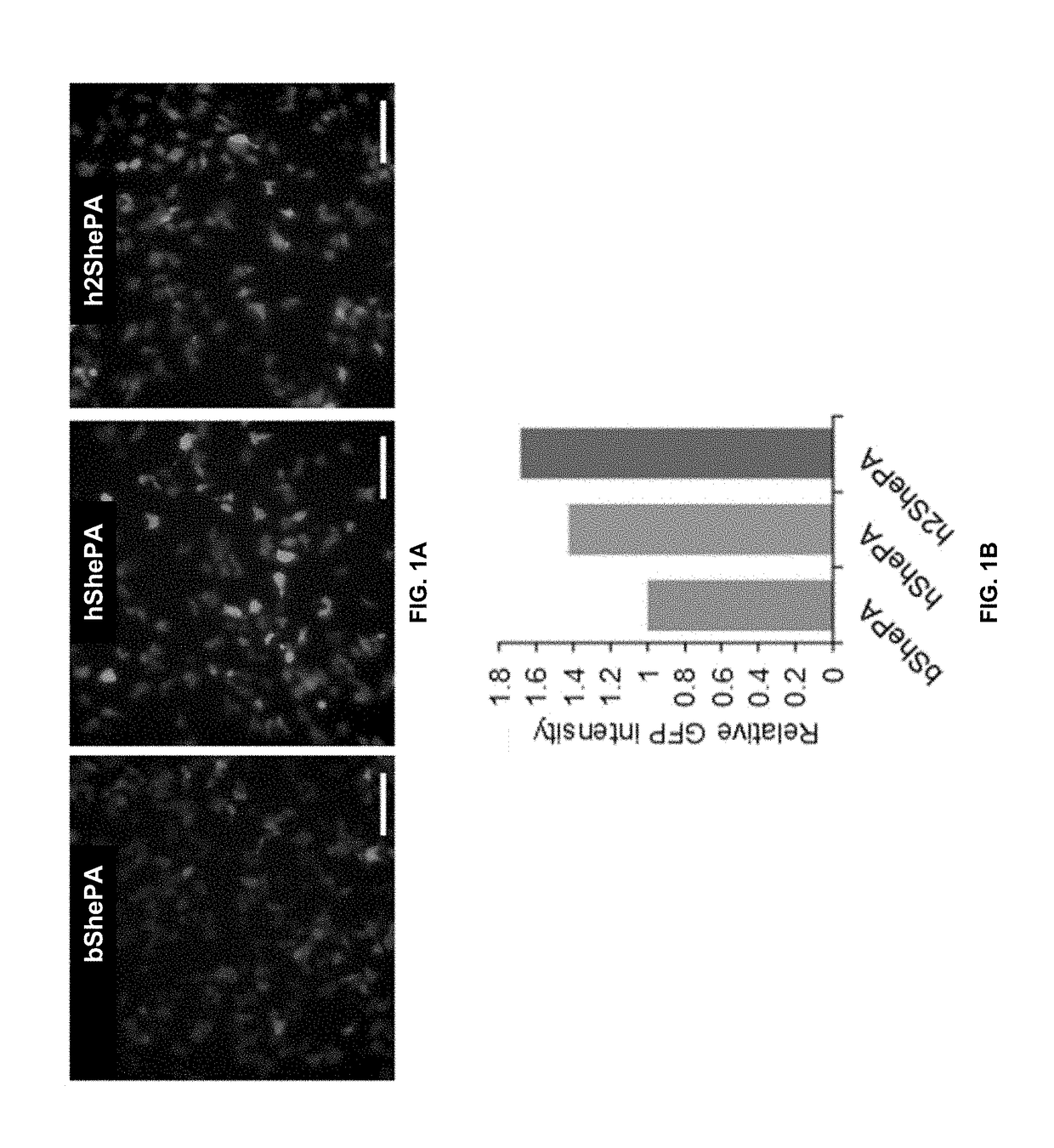Use of bacterial voltage gated ion channels for human therapies
a technology of ion channels and bacterial cells, applied in the field of prokaryotic ion channel polypeptides, can solve the problems of long-term disability and death, inability to treat such disorders, and inability to maintain excitability, so as to increase the conductivity of cardiac tissue, increase the resistance to conduction block, and increase the upstroke speed of cardiac tissu
- Summary
- Abstract
- Description
- Claims
- Application Information
AI Technical Summary
Benefits of technology
Problems solved by technology
Method used
Image
Examples
example 1
Materials and Methods
[0121]Characterization of human codon-optimized NavSheP D60A constructs. Human codon optimization of bacterial NavSheP D60A (bShePA) gene was performed via Genscript OptimumGene algorithm (Liu, X. et al. Google Patents, 2012) (hShePA) and ATUM Gene-GPS™ algorithm (Welch, M. et al. PloS One 2009, 4, e7002) (h2ShePA). Wild-type and codon-optimized sequences are listed below. Human codon optimized cDNAs were synthesized by respective companies and subsequently subcloned into CMV-driven, bi-cistronic lentiviral plasmids where they were linked with eGFP via the T2A peptide. Lentiviral plasmid containing the non-optimized channel co-expressed with eGFP (bShePA-T2A-eGFP) served as the control. Lentiviruses for each plasmid were made as described in the previous section, diluted to the same titer (˜1.7×108 transduction units / mL), and transduced into HEK293 cells monoclonally derived for Kir2.1 expression. Flow cytometry was used to ensure similar percentage of transduce...
example 2
Improvement of BacNav Expression Via Codon Optimization
[0124]Since NavSheP D60A and EGFP genes are linked via the T2A peptide in each lentiviral construct, any change in transcriptional and translational efficiencies of NavSheP D60A gene as a result of codon optimization is expected to effect change in EGFP expression level. Indeed, under similar functional titers, transduction of monoclonal HEK293 line expressing Kir2.1 with bShePA-EGFP virus yielded lower EGFP intensity compared to both optimized versions (hShePA-EGFP and h2ShePA-EGFP) (FIG. 1A), with ATUM optimized construct showing highest EGFP signal (FIG. 1B). Patch damp recordings revealed a similar trend for NavSheP D60A channel expression, with hShePA and h2ShePA exhibiting 3.3-fold and 5.4-fold increases in peak INa (−204±29 and −312±17 pA / pF) respectively, compared to non-optimized bShePA (−58±5 pA / pF). As a result, AP upstrokes were improved 2.5 and 3.8 times using hShePA (168±36 V / s) and h2ShePA (252±28 V / s) respectivel...
example 3
Improvement of BacNav Channel Trafficking
[0125]In order to evaluate membrane trafficking of NavSheP D60A, we fused the channel to either the carboxyl or amino terminus of mEGFP. Fusion of mEGFP to channel's C-terminus (h2ShePA-mEGFP) resulted in primarily perinuclear labeling (FIG. 2A). Since the C-terminal domain of BacNav plays roles in channel assembly and stability of the tetrameric structure, the addition of fluorescence reporter at the C-terminal domain may hinder these processes. In contrast, mEGFP fused at the N-terminus of NavSheP D60A (mEGFP-h2ShePA) showed significantly improved channel spatial distribution; however, large intracellular aggregations were observed throughout the cell (FIG. 2B). Moreover, GFP pattern resembled the endoplasmic reticulum (ER) structure, suggesting that export from the ER could be the limiting step of NavSheP D60A trafficking. In order to minimize intracellular aggregation and improve ER export of these channels, we added to their carboxyl ter...
PUM
| Property | Measurement | Unit |
|---|---|---|
| voltage gated | aaaaa | aaaaa |
| conductivity | aaaaa | aaaaa |
| resistance | aaaaa | aaaaa |
Abstract
Description
Claims
Application Information
 Login to View More
Login to View More - R&D
- Intellectual Property
- Life Sciences
- Materials
- Tech Scout
- Unparalleled Data Quality
- Higher Quality Content
- 60% Fewer Hallucinations
Browse by: Latest US Patents, China's latest patents, Technical Efficacy Thesaurus, Application Domain, Technology Topic, Popular Technical Reports.
© 2025 PatSnap. All rights reserved.Legal|Privacy policy|Modern Slavery Act Transparency Statement|Sitemap|About US| Contact US: help@patsnap.com



